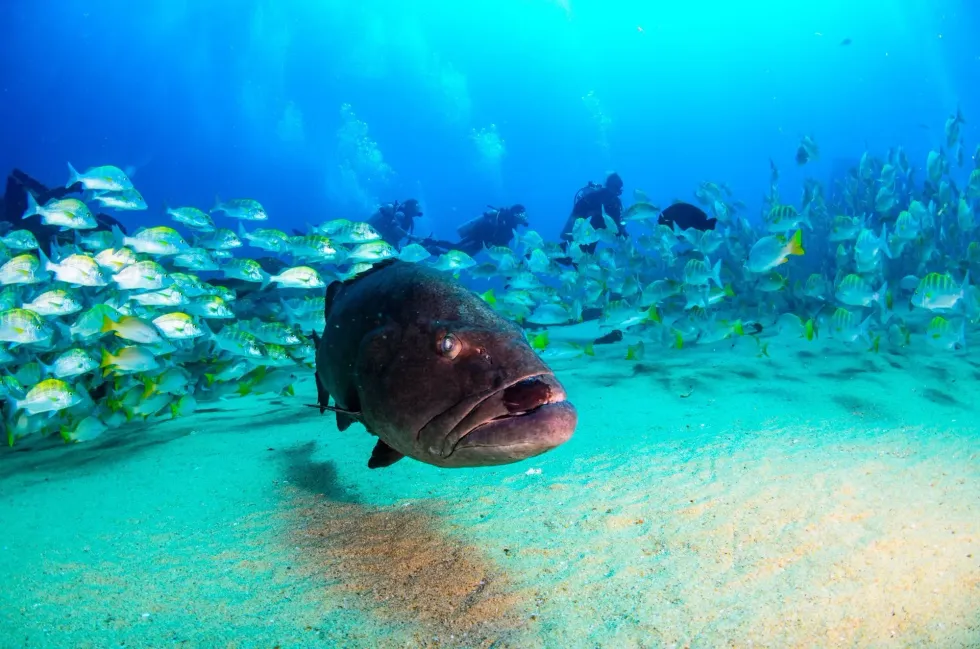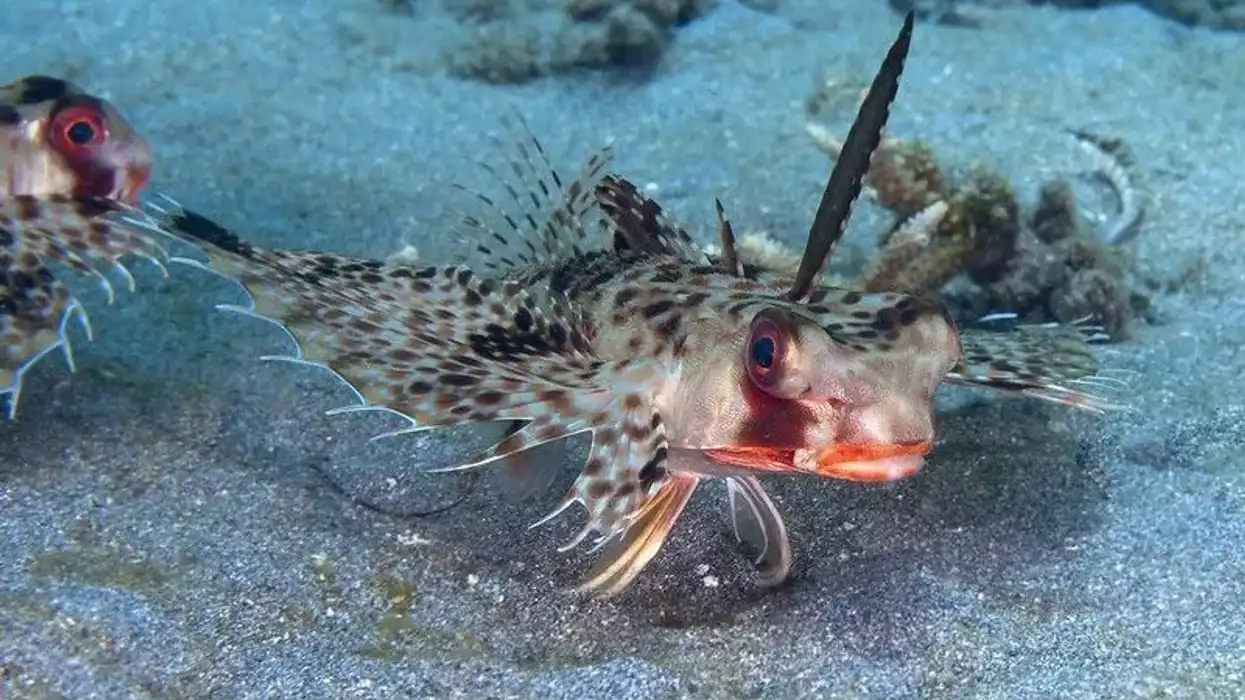There are a total of 159 species of groupers in the world. The Gulf grouper, Mycteroperca jordani, is a fish from the same family as many other groupers.
The Gulf grouper, Mycteroperca jordani, is a carnivore that feeds on smaller fish, shrimp, and crabs. Gulf grouper, Mycteroperca jordani, fish are ambush predators and these fish are spotted in the Gulf of California, in Mexican waters in the Gulf of Mexico, and in the Pacific Ocean.
The Gulf grouper is classified as an Endangered species by the IUCN Red List. Major threats they face apart from predators include habitat loss, habitat degradation, and overfishing. Certain grouper species are consumed as a delicacy in different parts of the world too.
They are considered high in nutritional value and have a mild flavor. The Gulf grouper breeds through external fertilization and they spawn from April to June. These fish are protogynous hermaphrodites, meaning that they are born as females at birth and transition into males.
For more relatable content, check out these flounder and red grouper facts.
Gulf Grouper Interesting Facts
What type of animal is a Gulf grouper?
A Gulf grouper is a type of fish that belongs to the kingdom Animalia and the order Perciformes.
What class of animal does a Gulf grouper belong to?
A Gulf grouper is a type of fish that belongs to the class Actinopterygii, the family Serranidae, and the genus Mycteroperca.
How many Gulf groupers are there in the world?
The exact population of Gulf groupers is not known. Their populations have declined rapidly since the mid 20th century owing to them being harvested by fisheries and becoming subject to overfishing.
In Florida, fishing for groupers occurs year-round hence, this fish is always in season in Florida. Its prime time is October to December and it is a popularly consumed fish in Florida. Fishing for these fish during times when they are spawning is not preferable as this may impact their population status.
Where does a Gulf grouper live?
The Gulf grouper, Mycteroperca jordani, is seen in oceans (specifically the Pacific ocean), coastal areas, rocky terrain, and shallow waters. Grouper species are largely bottom-dwelling species.
They are seen in the Gulf of California and in Mexican waters in the Gulf of Mexico. The Gulf of Mexico is home to various fish species and whale sharks are the biggest fish in the Gulf of Mexico. Fishing is a popular event in the Gulf of Mexico and in California.
What is a Gulf grouper's habitat?
The typical Gulf grouper habitat constitutes oceans, coastal areas, shallow waters, and rocky terrains on the bottom of the water body. Groupers spawn offshore, similar to reef fish as reef fish are also known to spawn in offshore areas.
Their habitat in the Gulf of Mexico and beyond is majorly under threat which has greatly impacted them, resulting in some population degradation in the last few years.
Who do Gulf groupers live with?
Groupers can be seen traveling in groups. There are three primary reasons for this: safety, feeding, and breeding. The primary reason they travel in schools is to protect themselves from falling prey to bigger predators and fishing.
It also allows them to feed effectively since they can more effectively attack their prey together. They also come together during the breeding season to reproduce young fry. They also coexist with other marine species in water bodies.
How long does a Gulf grouper live?
The Gulf grouper has been recorded to live up to 48 years. They attain sexual maturity by six years and transition from female to male as they grow.
How do they reproduce?
Females usually gather together in large groups for spawning once each year. The Gulf grouper season for spawning occurs from April to June. Common breeding spots include rocky reefs, underwater mountains, and other similar regions.
Groupers are born as females and gradually transition into males. Their eggs are deposited externally through spawning and develop independently without any assistance from their parents. These fish are known to lay multiple eggs.
What is their conservation status?
The Gulf grouper is classified as an Endangered species by the International Union for Conservation of Nature's IUCN Red List. Their population has declined rapidly owing to habitat loss, habitat degradation, and overfishing when they are caught by fishermen for commercial purposes.
Fishing for these fish during times when they spawn is not preferable as this may impact their population status.
Gulf Grouper Fun Facts
What do Gulf groupers look like?
Gulf groupers are medium to large-sized fish. Their overall color is dark brown to gray and these fish prefer residing in deep, not shallow, waters.
Their length is 60 in (152.4 cm) and their weight is 200 lb (90.71 kg). Their bodies are rounded and not flat and they have dorsal, anal, and pectoral fins. Their mouth is differently shaped as compared to other rocky reef fish They also have two eyes on either side.

*Please note that the image is of a giant grouper, not a Gulf grouper. If you have an image of a Gulf grouper please let us know at hello@kidadl.com.
How cute are they?
These fish are not conventionally cute however, they are exotic species and are caught by fishermen for commercial purposes. They can be spotted in California, Mexico, and other places where they are a popular choice for fisheries. Fishermen fish for them for selling for consumption.
How do they communicate?
The primary means of communication for this species are through sound, color, and smell. They utilize this to track their movements. They are specifically aware of their surroundings when a predator arrives or when they are ready to attack.
How big is a Gulf grouper?
A Gulf grouper is 60 in (152.4 cm) in length. This is five times bigger than the strawberry grouper which is 12 in (30.48 cm) length. The biggest grouper fish is the giant grouper and this fish can grow lengths up to 98.42 in (2.5 m). The giant grouper is also called the Goliath grouper.
How fast can a Gulf grouper swim?
Gulf grouper fish swim at relatively slow speeds and can be spotted in the same spot for long periods of time. Sailfish are considered to be the fastest fish in the ocean.
How much does a Gulf grouper weigh?
A Gulf grouper weighs 200 lb (90.71 kg). The heaviest grouper is the giant grouper. Giant grouper fish (also known as Goliath grouper fish) are not easy to catch and take a lot of effort as they are such a large fish species.
What are their male and female names of the species?
Male and female grouper fish are not addressed differently. A grouper is born female at birth and transitions into a male in the later stages of their life.
What would you call a baby Gulf grouper?
A baby Gulf grouper is initially referred to as an egg and then the newborn Gulf grouper is referred to as fry. They develop through various stages in their life cycle.
What do they eat?
Grouper fish are primarily carnivorous in nature. They feed on fish, shrimp, and crab and reside in deep levels of the ocean. The grouper is an ambush predator and preys on smaller fish species. Predators to gulf grouper fish include king mackerel, the barracuda, and eels who also are seen in deep levels of water.
Are they poisonous?
No, this fish species is not poisonous. They are caught and consumed by people around the world, but consuming them in sensible quantities is essential. The Center for Disease Control and Prevention (CDC) warns people to only consume grouper in limited amounts.
Would they make a good pet?
No, gulf groupers have a high chance of growing into huge fish so it's not ideal to keep them as pets.
If you are considering buying or adopting a pet fish you could consider smaller fish species or related fish Gulf groupers can be kept protected in aquariums and preservation centers for fish as they need to be protected from habitat loss, habitat degradation, and overfishing.
Did you know...
A quarter of all marine species live in reef-rich environments. Very few survive without a good reef environment so the degradation of coral reef environments had posed a major threat to the survival of many species.
Commercial fisheries bring in 160 billion lb (72,574,779,200 kg) of catch around the world each year. Approximately 40 % of such catch is discarded on a global level.
Certain fish have feet. Grouper fish don't but some fish species do. These feet are not technically feet but they are actually fins that act as feet. Feet are present in Schaefer's anglerfish and these feet are popularly seen in bottom dwellers of a water body.
Catching and eating Gulf groupers
Gulf groupers are caught by fishermen around the world. If you wish to go fishing for these species you will need to invest in the right equipment for fishing and choose a fishing site where you can find these fish easily.
Grouper fishes can be attracted both by live and dead bait. This might require patience and time since they don't appear straight away. When they do appear, it's essential to ensure that the bait set and the equipment used are strong enough to handle their weight.
Grouper fishes are bottom dwellers hence it's difficult to find them easily. Adult grouper fishes feed only on fish. They come out to hunt during dusk and dawn hours and they have a mild flavor.
There might be slight differences in the flavor and texture of these fish differing from one region to another. Fishing for this species is relatively simple as long as you follow the steps provided above. Fishing for them during times when they are spawning is not preferable as this may impact their population status.
Do Gulf groupers attack humans?
Gulf groupers are caught by fisheries for commercial purposes and they are a preferred catch by fisheries. Overfishing by fisheries for commercial purposes is a major threat to their population.
However, these fish can threaten humans sometimes too, the New York Times once reported a case in the '50s when a child was attacked by a Goliath grouper. This shows that grouper fish can be dangerous to humans.
Here at Kidadl, we have carefully created lots of interesting family-friendly animal facts for everyone to discover! Learn more about some other fish from our brown trout facts and pumpkinseed sunfish facts pages.
You can even occupy yourself at home by coloring in one of our free printable gulf grouper coloring pages.










